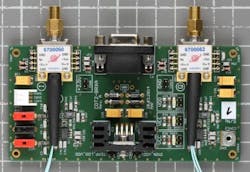Multimode optical receivers increasingly deployed for space-to-ground laser communication links
Discovery Semiconductors (Ewing, NJ) reports that its multimode optical receivers operating at up to 10 Gb/s are being increasingly used for space-to-ground laser communication links by Tesat Spacecom (Backnang, Germany) as well as by the European Space Agency (ESA).
"Using a multimode optical receiver in conjunction with a self-referencing differential phase shift keying (DPSK) interferometer allows for the collection of photons up to 36 times more than that of a single mode fiber," says Zoran Sodnik, ESA’s Head of Opto-Electronics Section. "The low noise, multimode optical receivers are intended to be used at a data rate of 1.8 Gb/s for ESA’s Geostationary to Ground Station laser communication links.”Tesat Spacecom uses the balanced optical receivers as reference devices in their system test bed for laser communication terminals (LCTs). The LCTs are working at 1064 nm with a 1.8 Gb/s coherent binary phase-shift keying (BPSK) communication system, and the balanced receivers provide a low noise, high bandwidth standard.
Related article: Sophisticated optical systems extend reach of free-space communications
According to Frank Heine, Tesat Spacecom’s Chief Scientist and Head of LCT Laser System Engineering, “The receivers are used in Tesat’s Transportable Optical Ground Station (T-AOGS), which is currently located in Teneriffe, Spain. The first high-speed laser communication with a geostationary spacecraft [Alphasat] was recently achieved there.”
“We have been working with Tesat and ESA for 12 years on multiple space-related projects and are honored to be part of their team,” commented Abhay Joshi, President and CEO of Discovery Semiconductors.
Source: Discovery Semiconductors

Conard Holton
Conard Holton has 25 years of science and technology editing and writing experience. He was formerly a staff member and consultant for government agencies such as the New York State Energy Research and Development Authority and the International Atomic Energy Agency, and engineering companies such as Bechtel. He joined Laser Focus World in 1997 as senior editor, becoming editor in chief of WDM Solutions, which he founded in 1999. In 2003 he joined Vision Systems Design as editor in chief, while continuing as contributing editor at Laser Focus World. Conard became editor in chief of Laser Focus World in August 2011, a role in which he served through August 2018. He then served as Editor at Large for Laser Focus World and Co-Chair of the Lasers & Photonics Marketplace Seminar from August 2018 through January 2022. He received his B.A. from the University of Pennsylvania, with additional studies at the Colorado School of Mines and Medill School of Journalism at Northwestern University.

